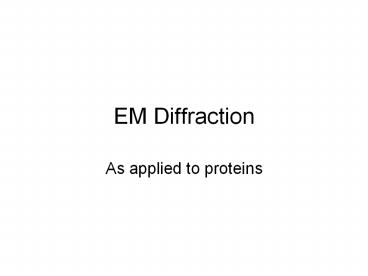EM Diffraction - PowerPoint PPT Presentation
1 / 21
Title:
EM Diffraction
Description:
If we can map the electron density distribution of the scattering material, we ... Projection density map of BR. How to access the third dimension? Tilt Series ... – PowerPoint PPT presentation
Number of Views:47
Avg rating:3.0/5.0
Title: EM Diffraction
1
EM Diffraction
- As applied to proteins
2
Diffraction from a grating
Molecular Expressions
3
Braggs Law
- N 2dsin(?)/?
- Derivation http//www.eserc.stonybrook.edu/Projec
tJava/Bragg/ - Applies to electron diffraction from crystals
- Therefore, the diffraction of electrons from a
crystal is quantized
4
Scattering factors
- What within the planes of the crystal is
scattering electrons? The electrons of the atoms
of the molecules. - If we can map the electron density distribution
of the scattering material, we can determine
crystal structure
5
Fourier Transform
We can model any function by adding together
waves that are integral multiples in
frequency F(x) C0 ?Cncos(2px/(?/n) an).
6
Scattering of waves by an object gives rise to a
Fourier transform
- http//micro.magnet.fsu.edu/primer/java/interferen
ce/doubleslit/ - The Fourier transform of a single spacing is a
single cosine wave (This is how diffraction
gratings work) - Note that small spacings in real space give rise
to large spacings in reciprocal space - This is the origin of the Rayleigh limit the
cone of scattering that can be collected by a
microscope is finite.
7
Inverse Fourier Transform
- A Fourier transform of a Fourier transform
generates the negative of the original function - We can therefore multiply this by -1 to give an
inverse Fourier transform Optically, this is
accomplished by a lens - However, all we can measure in the rear focal
plane of a microscope is the amplitudes of
scattered beams, not their phases - This is the origin of the phase problem in
diffraction
8
Electron diffraction crystal structure
- Electron diffraction is advantageous because the
diffracted electrons average over many repeats of
a structure - We can measure diffracted electron intensities
- How can we get their phases, so that we can use
an inverse Fourier transform to retrieve the
structure?
9
Electron Diffraction from BR
10
Electron Crystallography
- One way Do electron diffraction to measure
amplitude, and low-dose transmission electron
microscopy to get a direct image - Use the direct image to calculate phases
- This is extremely useful for proteins that for
microcrystals, or two dimensional crystals
11
Flow Chart (Henderson et al, 1990)
12
Examples
- 2-D crystals
- Purple membrane protein (bacteriorhodopsin) from
Halobacter halobium. - Light harvesting complex
- http//blanco.biomol.uci.edu/Membrane_Proteins_xta
l.html - Microcrystals
- Prion protein
- Catalase
13
Catalase crystals
Brink Lab, Baylor
14
Purple membrane protein (1990)
15
Techniques (Fujiyoshi)
- Membranes prepared from Halobacter halobium
- Crystals suspended in 3 trehalose
- Applied to carbon-coated melybdenum grids
- Plunged into liquid ethane to give vitreous ice
- Transferred to cryostage of EM (FEG)
16
Projection density map of BR
17
How to access the third dimension?Tilt Series
Note that because this is a 2-Dimensional
crystal, you are sampling the continuous Fourier
transform in the third dimension.
18
Section of 3 Å Electron Density map of BR
19
LHC-II
20
Aquaporin
21
Problems
- Stage needs to be chilled with liquid helium
(radiation damage) - Tilt series limited to 60 - limits Z resolution
- Field emission gun necessary































